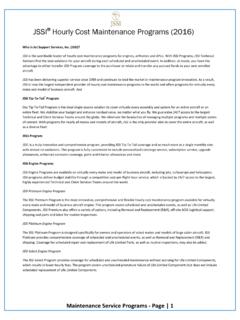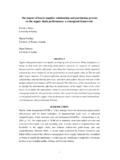Transcription of Information and methodology of sigma explorer data
1 Information and methodology of sigma explorer data How to use There is a short video explaining the main functionalities. Data set The web application contains data from the annual sigma reports on natural catastrophes (catastrophe database) and on the world insurance markets (world insurance database; see ). In the case of the catastrophe database, only a subset of the individual catastrophes is shown, ie the twenty largest events for each year by the number of victims, by insured losses or by total losses (excluding events from the US). Catastrophe database: terms and selection criteria Natural catastrophes A natural catastrophe is caused by The term "natural catastrophe" refers to an event caused by natural forces. Such an natural forces. event generally results in a large number of individual losses involving many insurance policies.
2 The scale of the losses resulting from a catastrophe depends not only on the severity of the natural forces concerned, but also on man-made factors, such as building design or the efficiency of disaster control in the afflicted region. In this sigma study, natural catastrophes are subdivided into the following categories: floods, storms, earthquakes, droughts/forest fires/heat waves, cold waves/frost, hail, tsunamis, and other natural catastrophes. Man-made disasters A man-made or technical disaster is major events associated with human activities are categorised as "man-made" or triggered by human activities. "technical" disasters. Generally, a large object in a very limited space is affected, which is covered by a small number of insurance policies. War, civil war, and war-like events are excluded.
3 sigma subdivides man-made disasters into the following categories: major fires and explosions, aviation and space disasters, shipping disasters, rail disasters, mining accidents, collapse of buildings/bridges, and miscellaneous (including terrorism). In Tables 8 and 9 (pages 26 44), all major natural catastrophes and man- made disasters and the associated losses are listed chronologically. Total losses Losses due to property damage and For the purposes of the present sigma study, total losses are all the financial losses business interruption that are directly directly attributable to a major event, ie damage to buildings, infrastructure, vehicles etc. attributable to major events are included The term also includes losses due to business interruption as a direct consequence of in this study. the property damage.
4 Insured losses are gross of any reinsurance, be it provided by commercial or government schemes. A figure identified as "total damage" or "economic loss" includes all damage, insured and uninsured. Total loss figures do not include indirect financial losses ie loss of earnings by suppliers due to disabled businesses, estimated shortfalls in GDP and non-economic losses, such as loss of reputation or impaired quality of life. The amount of the economic losses is a Generally, total losses are estimated and communicated in very different ways. As a general indication only. result, they are not directly comparable and should be seen only as an indication of the general order of magnitude. Insured losses The term losses refer to insured losses, "Losses" refer to all insured losses except liability. Leaving aside liability losses, on one but do not include liability.
5 Hand, allows a relatively swift assessment of the insurance year; on the other hand, however, it tends to understate the cost of man-made disasters. Life insurance losses are also not included. NFIP flood damage in the US. NFIP flood damage in the US is included. The sigma catastrophe database also includes flood damage covered by the National Flood Insurance Program (NFIP) in the US, provided that it fulfils the sigma selection criteria Information and methodology of sigma explorer data sigma has been publishing tables listing major losses since 1970. Thresholds with respect to casualties the number of dead, missing, severely injured, and homeless . also make it possible to tabulate events in regions where the insurance penetration is below average. Thresholds for insured losses and For the 2016 reporting year, the lower loss thresholds were set as follows: casualties in 2016.
6 Insured losses (claims): Maritime disasters USD million Aviation USD million Other losses USD million or Economic losses: USD million or Casualties: Dead or missing 20. Injured 50. Homeless 2000. Adjustment for inflation, changes to published data, Information Losses are determined using year-end sigma converts all losses for the occurrence year not given in USD into USD using the exchange rates and are then adjusted for end-of-year exchange rate. To adjust for inflation, these USD values are extrapolated inflation. using the US consumer price index to give current (2016) values. This can be illustrated by examining the insured property losses arising from the floods which occurred in the UK between 29 October and 10 November 2000: Insured loss at 2000 prices: USD Insured loss at 2016 prices: USD million Alternatively, were one to adjust the losses in the original currency (GBP) for inflation and then convert them to USD using the current exchange rate, one would end up with an insured loss at 2016 prices of USD 1 million, 18% less than with the standard sigma method.
7 The reason for the difference is that the value of the GBP declined by almost 18% against the USD in the period 2000-2016, less than the difference in inflation between the US ( ) and the UK ( ) over the same period. Figure 9 Floods UK Exchange rate US inflation Alternative methods of adjusting for 29 October - 10 November 2000 GBPm USD/GBP USDm USDm inflation, by comparison Original loss 1, 1, Level of consumer price index 2000 Level of consumer price index 2016 Inflation factor Adjusted for inflation to 2016 1, 1, Comparison 82% 100%. Source: Swiss Re Economic Research & Consulting. If changes to the loss amounts of previously published events become known, sigma Changes to loss amounts of previously takes these into account in its database. However, these changes only become evident published events are updated in the when an event appears in the table of the 40 most costly insured losses or the 40.
8 sigma database. disasters with the most fatalities since 1970 (See Tables 10 and 11 on pages 45-46). Only public Information used for man- In the chronological lists of all man-made disasters, the insured losses are not shown for made disasters data protection reasons. However, the total of these insured losses is included in the list of major losses in 2016 according to loss category. sigma does not provide further Information on individual insured losses or about updates made to published data. Information and methodology of sigma explorer data Sources Newspapers, direct insurance and Information is collected from newspapers, direct insurance and reinsurance periodicals, reinsurance periodicals, specialist specialist publications (in printed or electronic form) and reports from insurers and publications and other reports are used reinsurers.
9 In no event shall Swiss Re be liable for any loss or damage arising in to compile this study. connection with the use of this Information (see the copyright Information on page 2). Exchange rate used 1, national currency per USD. Country Currency Exchange rate, end 2016. United Arab Emirates AED Australia AUD Canada CAD Europe CHF China CNY Costa Rica CRC Egypt EGP Eurozone EUR Fiji FJD United Kingdom GBP India INR Japan JPY South Korea KRW Sri Lanka LKR New Zealand NZD Oman OMR Philippines PHP Qatar QAR Russia RUB Tonga TOP Taiwan TWD USD South Africa ZAR 1. The losses for 2016 were converted to USD using these exchange rates. No losses in any other currencies were reported Information and methodology of sigma explorer data World insurance: methodology and Data The premium data in sigma - explorer sigma is based on the direct premium volume of insurance companies, regardless of whether they are privately or state owned.
10 Premiums paid to state social insurers are not included. Life and non-life premium volume in 147 countries is examined. Detailed Information on the largest 88 countries in terms of total insurance premium volume can be found in the statistical appendix. Country classifications generally follow The designation of the economies mentioned in this sigma as "advanced" or "emerging". IMF conventions. is generally in keeping with the conventions of the International Monetary Fund (IMF). Advanced economies include the US, Canada, Western Europe (excluding Turkey), Israel, Oceania, Japan and the other advanced Asian economies (Hong Kong, Singapore, South Korea and Taiwan). All other countries are classified as "emerging" and generally correspond to the IMF's "emerging and developing" economies. 2. Data sources The insurance data and estimates contained in the study originate primarily from national supervisory authorities and, in some cases, from insurance associations.


